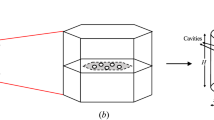Abstract
In order to clear the relationship between dislocation development and endurance limit in fatigued body-centered cubic (BCC) metals, the automotive grade interstitial-free steel (IF steel) was fatigued near the endurance limit in this study. When cycling just below the endurance limit, the dislocation structures are mainly composed of loop patches, moreover, a few large dislocation cells and dislocation walls can also be found, and thus these structures have no significant effect on fatigue failure. However, once cyclic strain slightly exceeds the endurance limit, the small dislocation cells tend to develop near grain boundaries and triple junction of the grains, and which provide a more appropriate structure for crack growth than do large dislocation cells.






Similar content being viewed by others
References
Majumdar S, Bhattacharjee D, Ray KK (2008) Metall Mat Trans A 39:1676
Fuchs HO, Stephens RI (1980) Metal fatigue in engineering. Wiley, New York
Narasaiah N, Chakraborti PC, Maiti R, Ray KK (2005) ISIJ Int 45:127
Ma BT, Laird C, Leovich Radin A (1990) Mater Sci Eng A 123:159
Liu W, Bayerlein M, Mughrabi H, Day A, Quested PN (1992) Acta Metall Mater 40:1763
Ma BT, Laird C (1988) Mater Sci Eng A 102:247
Toribio J, Kharin V (2006) J Mater Sci 41:6015. doi:https://doi.org/10.1007/s10853-006-0364-5
Chen CY, Huang JY, Yeh JJ (2003) J Mater Sci 38:817. doi:https://doi.org/10.1023/A:1021817216519
Dickson JI, Handfield L, L’espérance G (1986) Mater Sci Eng 81:477
Huang HL, Ho NJ (2000) Mater Sci Eng A 279:254
Kaneko Y, Ishikawa M, Hashimoto S (2005) Mater Sci Eng A 400–401:418
Huang HL, Ho NJ (2001) Mater Sci Eng A 298:251
Murakami Y (1980) Int J Fatigue 2:23
Endo T, Murakami Y (1987) J Eng Mater Technol 109:124
Figueroa JC, Bhat SP, Delaveaux R, Murzenski S, Laird C (1981) Acta Metall 29:1667
Sommer C, Mughrabi H, Lochner D (1998) Acta Mater 46:1537
Awatani J, Katagiri K, Nakai H (1978) Metall Trans 9A:111
Ogura T, Masumoto T (1976) Trans Jpn Inst Met 17:733
Awatani J, Katagiri K, Shiraishi T (1976) Metall Trans 7A:807
Acknowledgements
This work is supported by the National Science Council of ROC under Contract NSC-96-2628-E-110-007. China Steel Corp. is acknowledged for providing the material.
Author information
Authors and Affiliations
Corresponding author
Rights and permissions
About this article
Cite this article
Shih, CC., Ho, NJ. & Huang, HL. Dislocation evolution in interstitial-free steel during fatigue near the endurance limit. J Mater Sci 45, 818–823 (2010). https://doi.org/10.1007/s10853-009-4005-7
Received:
Accepted:
Published:
Issue Date:
DOI: https://doi.org/10.1007/s10853-009-4005-7




